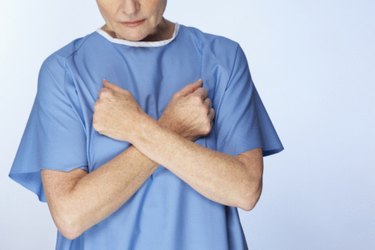
Exercise is beneficial for heart, lung, bone and tissue health. However, exercise can sometimes lead to unknown pains that can alarm unsuspecting exercisers. Pain in your sternum -- or breast bone -- during exercise can occur as the result of a variety of conditions or injuries. While most problems are simple and not life-threatening, always consult your physician if you experience sternum pain while exercising.
Costochondritis
Video of the Day
Costochondritis is an inflammation of the cartilage that surrounds your sternum. Exercise and the heavy breathing that often accompanies exercise can make the symptoms of costochondritis more prevalent. The symptoms of costochondritis can be alarming due to the fact that they mimic the symptoms of a heart attack, including pain and tenderness along the breast bone, pain when breathing or coughing, and difficulty breathing. Visit your doctor if you experience these pains because costochondritis can be the result of an infection. Treatment includes muscle relaxants and anti-inflammatory medications.
Video of the Day
Sprains
Abnormal twisting and turning -- especially turning core exercises -- can lead to a pulled muscle or torn cartilage in your sternum area. Pain is normally felt along the sternum, and tends to decrease when you rest and increase when you participate in physical activity.
Fractures
A sternum fracture can occur as the result of a fall during exercise or a direct blow to the chest during participation in contact sports. Common symptoms of a chest fracture include pain, tenderness, visual deformity and bruising. Most sternum fractures are treated with rest and discontinuing exercise until you are healed. Only sternum fractures that cause damage to your internal organs require more complex treatment and possible surgery to repair the damage.
Angina
Angina can cause a tight, heavy feeling in your chest near your sternum. This is a result of reduced blood flow to the heart. Angina can be a sign of heart disease and should be treated by a physician as soon as possible. You may also experience pain in your arms, neck, shoulders, back and jaw, in addition to nausea, fatigue, shortness of breath, sweating, dizziness and anxiety. Angina triggered by physical exertion or exercise is termed "stable angina." This type of angina is only triggered during physical exertion. Simple lifestyle changes can help to treat stable angina; these include taking breaks during exercise, controlling your weight, not eating large meals, managing diabetes and not smoking.
Is this an emergency? If you are experiencing serious medical symptoms, please see the National Library of Medicine’s list of signs you need emergency medical attention or call 911.